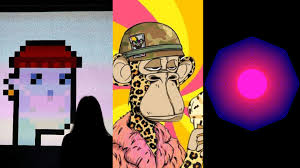Non-Fungible Tokens (NFTs) have taken the world by storm, transforming how we think about ownership, art, and digital assets. From multimillion-dollar digital artworks to virtual land and collectible memes, NFTs are now a cornerstone of the blockchain economy. But where did this phenomenon start? How did the idea of a unique, blockchain-based token evolve into a cultural and financial juggernaut? Let’s dive into the origins of NFTs, explore the first-ever NFT, and uncover the pioneers who set this revolution in motion.
What Sparked the NFT Concept?
The idea of NFTs emerged from the intersection of blockchain technology, digital scarcity, and the desire to prove ownership in a virtual world. Unlike cryptocurrencies like Bitcoin or Ethereum, which are fungible (meaning one coin is interchangeable with another), NFTs are unique, indivisible digital assets. Each NFT has distinct metadata, verified on a blockchain, ensuring its authenticity and ownership. This concept of “non-fungibility” was a game-changer, enabling digital items—art, music, virtual goods—to have provable scarcity and value, much like physical collectibles.
The roots of NFTs trace back to the early 2010s, when blockchain technology, introduced by Bitcoin in 2009, began inspiring new use cases. Developers started exploring how blockchains could do more than just record financial transactions. The idea of tokenizing unique assets gained traction with the launch of Ethereum in 2015, which introduced smart contracts—self-executing programs that could embed ownership rules and metadata. This innovation laid the technical foundation for NFTs, allowing creators to mint digital assets with verifiable uniqueness.
Early Experiments in Digital Ownership
Before NFTs had a name, early blockchain projects toyed with the concept of unique digital assets. One of the first steps came in 2012 with Colored Coins on the Bitcoin blockchain. Colored Coins were small denominations of Bitcoin “marked” to represent specific assets, like property or collectibles. While innovative, they were limited by Bitcoin’s rigid scripting language, which wasn’t designed for complex applications. Still, Colored Coins planted the seed for tokenizing unique items, inspiring later developments.
By 2014, projects like Counterparty, a platform built on Bitcoin, took things further. Counterparty allowed users to create custom tokens, including rare digital assets like trading cards for the game Spells of Genesis. These early tokens, while not NFTs in the modern sense, introduced the idea of blockchain-based collectibles. Another milestone was Namecoin, a 2011 project that used blockchain to register domain names as unique digital assets. These experiments showed that blockchains could track ownership of non-financial items, setting the stage for NFTs.
The First True NFT: Quantum
The title of the first true NFT goes to Quantum, created on May 2, 2014, by digital artist Kevin McCoy and technologist Anil Dash. Minted on the Namecoin blockchain, Quantum is a pixelated, octagon-shaped animation resembling a pulsating digital gem. McCoy, inspired by his work in digital art, wanted to address a problem: how could artists prove ownership of digital creations in an era of easy copying? Together with Dash, he envisioned a blockchain-based solution to establish provenance and authenticity.
Quantum was a proof-of-concept for what McCoy and Dash called “monetized graphics”—digital artworks tied to a blockchain to verify ownership. Unlike later NFTs on Ethereum, Quantum used Namecoin’s decentralized registry to record its metadata. The artwork was showcased at the Seven on Seven conference in New York in 2014, where McCoy and Dash demonstrated how blockchain could empower artists to control their digital creations. While Quantum didn’t gain widespread attention at the time, it was a prophetic moment, proving that unique digital assets could exist on a blockchain.
In 2021, Quantum resurfaced when it was sold at Sotheby’s for $1.4 million, cementing its status as the first NFT. McCoy reflected on its significance, saying, “It was about giving artists a way to own their digital work, not just creating a speculative asset.” This vision of empowering creators remains a core principle of the NFT movement.
Ethereum and the Rise of ERC-721
While Quantum was a pioneering effort, the NFT boom required a more robust platform. Ethereum’s smart contracts provided the perfect environment. In 2017, the ERC-721 standard—a protocol for creating non-fungible tokens—was proposed by developers William Entriken, Dieter Shirley, Jacob Evans, and Nastassia Sachs. Unlike the earlier ERC-20 standard for fungible tokens (used for coins like USDC), ERC-721 allowed each token to have unique attributes, making it ideal for digital collectibles.
The ERC-721 standard was popularized by CryptoKitties, a blockchain game launched in November 2017 by Dapper Labs. In CryptoKitties, players could buy, breed, and trade unique virtual cats, each represented as an NFT on Ethereum. The game became a sensation, with some rare kitties selling for over $100,000. CryptoKitties not only showcased the potential of NFTs for gaming but also proved their commercial viability, drawing mainstream attention to the concept. The success of CryptoKitties inspired a wave of NFT projects, from digital art to virtual real estate.
From Niche to Cultural Phenomenon
The NFT concept evolved rapidly after CryptoKitties. In 2018, platforms like OpenSea emerged, creating marketplaces where users could easily mint, buy, and sell NFTs. Artists like Beeple began experimenting with NFT art, culminating in his 2021 sale of EVERYDAYS: The First 5000 Days for $69 million at Christie’s. This sale marked NFTs’ arrival as a cultural force, blending art, technology, and finance.
NFTs also expanded beyond art. Projects like Decentraland and The Sandbox used NFTs to represent virtual land, while musicians like Kings of Leon tokenized albums and concert tickets. Sports franchises embraced NFTs with collectible moments, like NBA Top Shot, also developed by Dapper Labs. By 2021, the NFT market exploded, with sales peaking at $25 billion, according to DappRadar. The term “NFT” even became Collins Dictionary’s Word of the Year in 2021, reflecting its cultural impact.
Roadblocks and Criticisms
The NFT boom wasn’t without controversy. Critics pointed to environmental concerns, as early Ethereum mining relied on energy-intensive proof-of-work. (Ethereum’s 2022 shift to proof-of-stake mitigated this.) Others argued that NFTs fueled speculation, with “rug pulls” and overhyped projects leaving some investors burned. Skeptics also questioned the value of digital ownership, asking why someone would pay millions for a JPEG. Yet defenders, including McCoy, argued that NFTs empower creators by providing new revenue streams and control over their work.
Posts on X reflect the polarized sentiment. Some users, like@NFTsAnonymous, celebrate NFTs as “the future of creativity,” while others, like@CryptoCriticX, call them “overpriced hype.” Despite the debates, NFTs have undeniably reshaped how we value digital assets.
The Lasting Impact of NFTs
The journey from Quantum to today’s NFT ecosystem shows how a niche idea became a global phenomenon. Kevin McCoy and Anil Dash’s 2014 experiment laid the groundwork for a technology that now spans art, gaming, music, and more. The ERC-721 standard and projects like CryptoKitties turned NFTs into a mainstream force, while platforms like OpenSea democratized access. Today, NFTs are integral to Web3, enabling decentralized economies and new forms of ownership.
Looking forward, NFTs are poised to evolve further. Innovations like fractionalized NFTs, dynamic tokens that change over time, and integration with AI and the metaverse promise to expand their use cases. As blockchain technology matures and regulations like the SEC’s Project Crypto provide clarity, NFTs could become a cornerstone of digital finance and culture.
The story of NFTs is one of vision, experimentation, and adaptation. From a pixelated octagon on Namecoin to billion-dollar markets, NFTs prove that digital scarcity and ownership are more than a fad—they’re a revolution.
Sources:
- CoinDesk: “The History of NFTs: From Quantum to Beeple”
- Decrypt: “What Was the First NFT? The Story of Quantum”
- The Verge: “How NFTs Became a $25 Billion Market”
- DappRadar: “NFT Market Report 2021”
- Sotheby’s: “Quantum NFT Sale, 2021”
- Ethereum.org: “ERC-721 Non-Fungible Token Standard”
- Cointelegraph: “The Rise of CryptoKitties and the NFT Boom”
- X Posts: @NFTsAnonymous, @CryptoCriticX



























